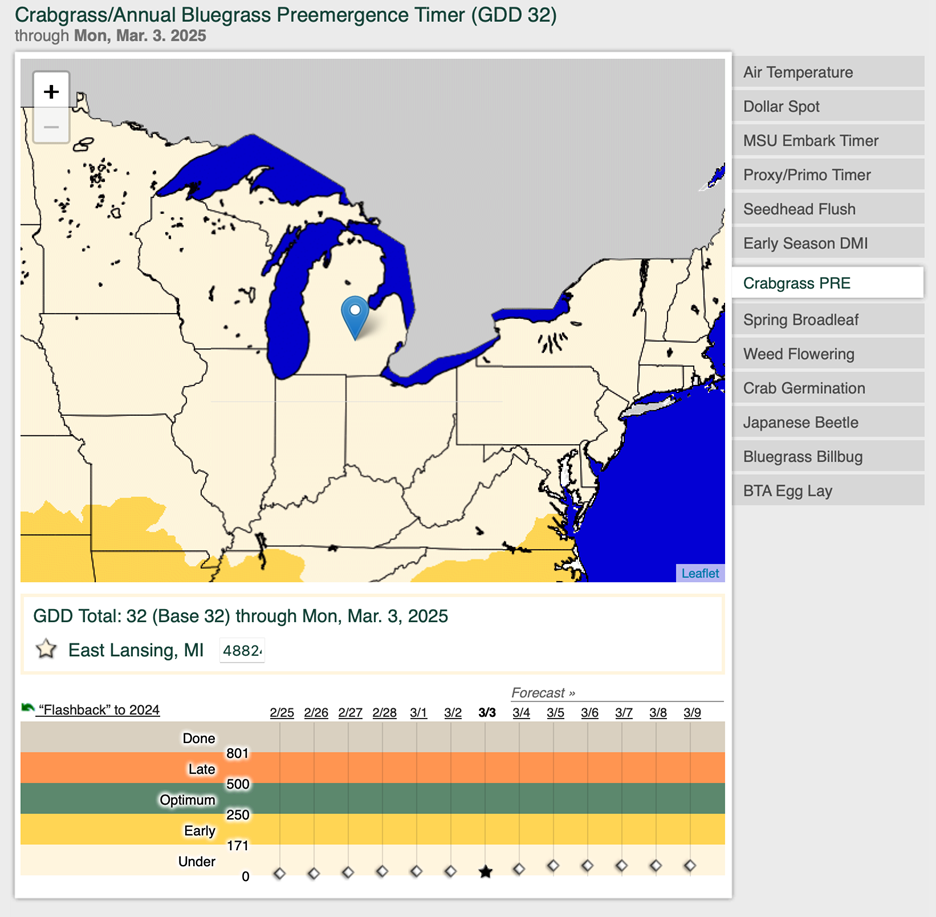Timing crabgrass preemergence applications in spring
When is the correct time to apply crabgrass preemergence herbicides in the spring?

Spring hasn’t officially arrived but with the snow quickly disappearing and temperatures forecast to be in the 50’s and even 60’s in some parts of the state in the next week, interest in spring lawn care is blooming. When is the best time to apply preemergence herbicides is a common question as spring arrives and lawns start growing again. There are several different methods used for determining the optimum application timing from tracking growing degree days (GDD) to looking for forsythia bush flower bloom. One system used by both professional turfgrass managers and do-it-yourselfers to determine application timing is to track GDDs using the website GDDTracker.
GDDTracker starts counting GDDs on Feb. 15. The crabgrass preemergence model uses GDD (base 32 degrees Fahrenheit) to indirectly measure soil temperatures in a turf situation (enter your zip code under the map and then click on “Crabgrass PRE”). The GDD model attempts to predict the optimum application timing for when the 0-2 inch depth soil temperatures consistently reach 50-55 F. Applications made at this time provide adequate time for the preemergence herbicide to be applied and watered in before crabgrass germination occurs.
Summer annual grasses such as crabgrass require proper soil temperature and moisture to germinate and establish. Eighty percent of germination will occur when soil temperatures at the 0-2 inch depth are consistently between 60 and 70 F. For preemergence herbicides to be effective, they need to be applied before the soils reach this optimum temperature range. At the Hancock Turfgrass Research Center on Michigan State University’s campus, soil temperature at a 2-inch depth is still just above freezing so it will still be some time before there will be any crabgrass germinating.

Though March 3, there is no location in the entire northern United States that is the optimum application window for crabgrass preemergence applications. Compared to 2024, GDD accumulation in 2025 is behind last year. On March 3, 2024, East Lansing had accumulated 133 GDD base 32; this year we’re at 32 GDD. The current forecast indicates warmer temperatures in the next couple weeks, so GDD accumulation will be increasing quickly.
Remember, the GDD models are meant to serve as guides, not absolutes. Keep in mind the range of the optimum application window extends from 250-500 GDD. You don’t have to apply the first day the model indicates optimum. We will stay in the optimum application window for at least two to three weeks, if not longer, depending on whether we have cool or warm temperatures going forward.
In addition to using soil temperatures and GDDTracker, a good environmental indicator for preemergence timing is when forsythia bushes are blooming with their bright yellow flowers.
Remember, the practices that encourage a healthy, dense turf stand, such as mowing high, returning clippings and adequate fertilization, are all part of an effective crabgrass prevention strategy.
This work is supported by the Crop Protection and Pest Management Program [grant no 2024-70006-43569] from the USDA National Institute of Food and Agriculture. Any opinions, findings, conclusions, or recommendations expressed in this publication are those of the author(s) and do not necessarily reflect the view of the U.S. Department of Agriculture.



 Print
Print Email
Email
